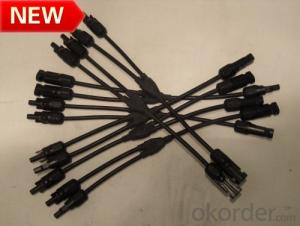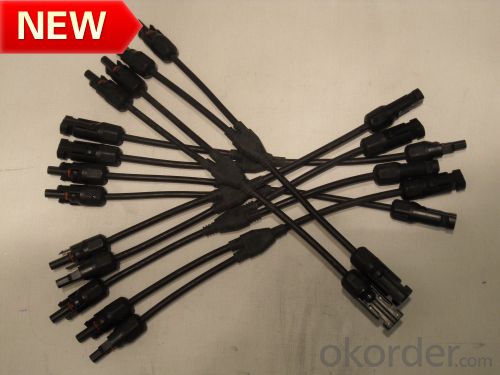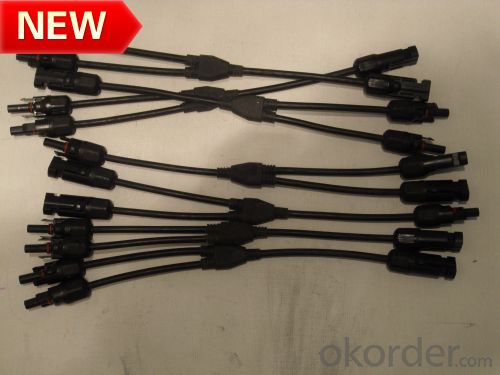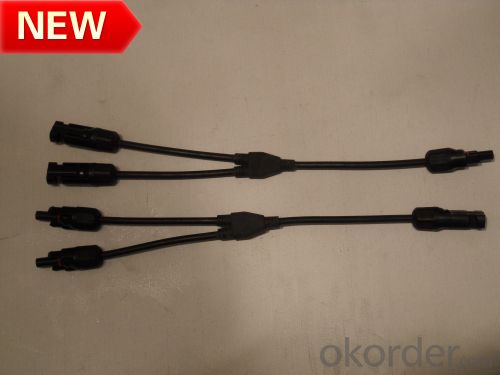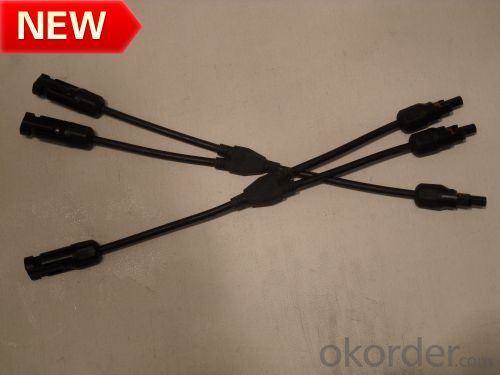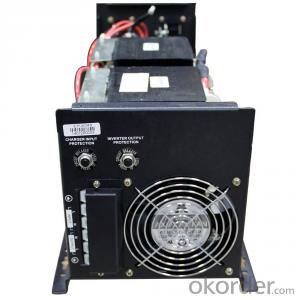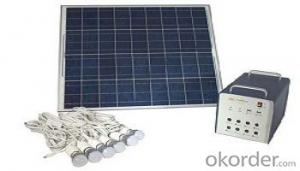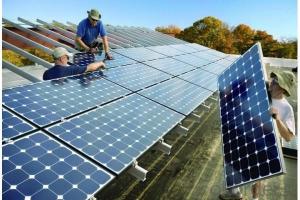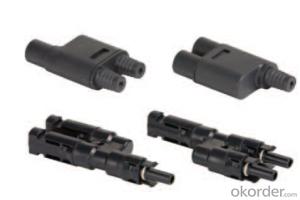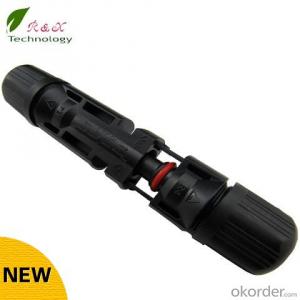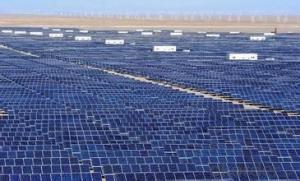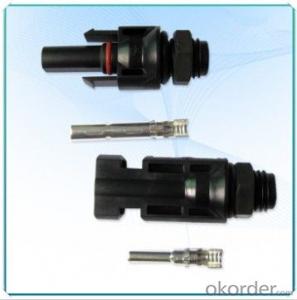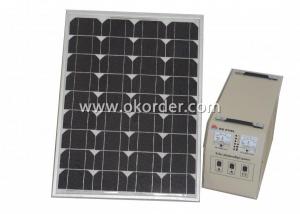Sells Solar Energy Systems PV System Branch Connector R4Y for PV Station
- Loading Port:
- Guangzhou
- Payment Terms:
- TT OR LC
- Min Order Qty:
- 50 set
- Supply Capability:
- 50000 set/month
OKorder Service Pledge
OKorder Financial Service
You Might Also Like
Brief introductions of product:
Connector R4Y System for photovoltaic adopts contact and insertion of reed with inner-knob type.It is used with male and famale points.pv junction box and cables made of elastomeric material and makes contact and isertion more certified by IEC61215 and TUV 2PFG1161.
Mainly parameters of product:
Rated voltage 1000V DC
Rated current 30A
Test volaage 6KV(50HZ,1min.)
Ambient temperaure range -40°C...+90°C
Upper limiting temperature 105°C
Degree of protection,mated IP67
unmated IP2X
Contact resistance of plug connectors 0.5m?
Safety class II
Contact system R4 Multilam
Type of termination Crimping
Contact material
Copper,tin plated
Locking system Snap-in(R4)
Cable type PV-F 1169 1*4mm2
1*6mm2
Design paper of product:
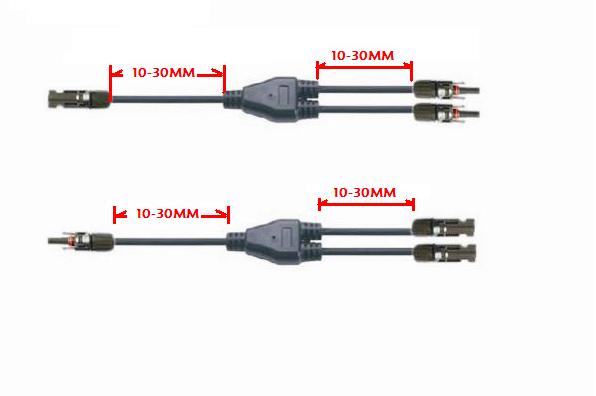
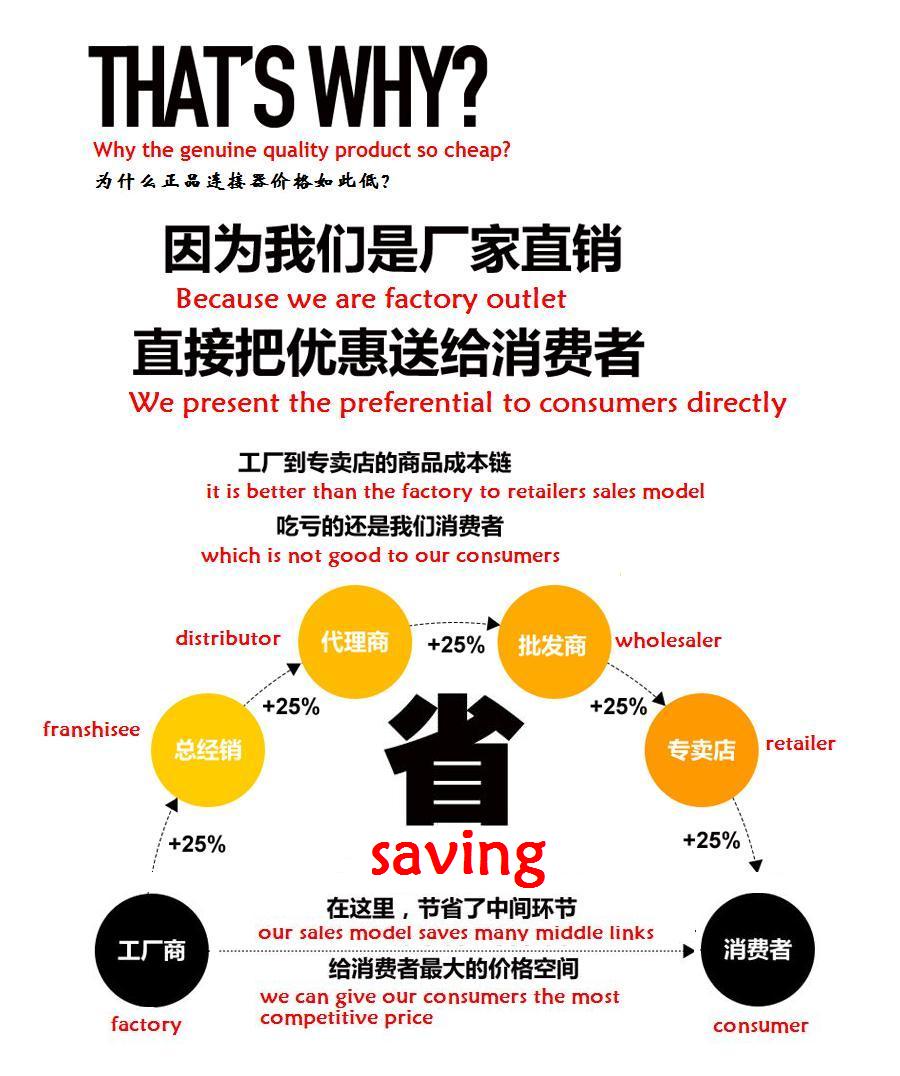
- Q: Can a solar energy system be installed on commercial buildings?
- Yes, a solar energy system can be installed on commercial buildings. In fact, many commercial buildings have already embraced solar energy as a viable and sustainable way to generate electricity. Commercial buildings provide ample rooftop space or open land areas that can be used to install solar panels. These panels can be integrated into the building's design or mounted on the rooftop, allowing them to capture sunlight and convert it into electricity. Installing a solar energy system on a commercial building offers several benefits. Firstly, it can help reduce energy costs significantly, as solar energy is a renewable and free source of power. Secondly, it can provide a clean and environmentally friendly alternative to traditional energy sources, reducing the building's carbon footprint. Additionally, commercial buildings with solar panels can benefit from various government incentives and tax credits that promote the use of renewable energy. Overall, the installation of a solar energy system on commercial buildings is not only feasible but also financially and environmentally advantageous.
- Q: What is the role of power optimizers in a solar energy system?
- Power optimizers play a crucial role in a solar energy system by maximizing the energy output of each individual solar panel. They optimize the power production by individually tracking the maximum power point of each panel, reducing losses caused by shading, uneven panel performance, and module mismatch. This ensures that the system operates at its highest efficiency, resulting in increased energy generation and improved overall system performance.
- Q: How do solar energy systems affect the carbon footprint?
- Solar energy systems have a significant positive impact on reducing carbon footprint. By harnessing the sun's energy to generate electricity, solar systems eliminate the need for fossil fuels, which are major contributors to carbon dioxide emissions. This clean and renewable source of energy not only helps combat climate change but also reduces air pollution and dependency on non-renewable resources.
- Q: Can solar energy systems be used in areas with high levels of windborne debris?
- Yes, solar energy systems can be used in areas with high levels of windborne debris. However, it is important to consider certain factors to ensure their effectiveness and longevity. Installing protective measures such as a sturdy frame, debris shields, or regular cleaning and maintenance can help mitigate any potential damage caused by windborne debris.
- Q: How do solar energy systems impact the structural integrity of a building?
- Solar energy systems have a minimal impact on the structural integrity of a building. In fact, they are designed to be installed on rooftops or as standalone structures without compromising the structure's stability. The weight of solar panels is relatively light, and modern technologies have made them even lighter than before. The panels are typically mounted on racks or frames that distribute the weight evenly across the surface area. Additionally, roof-mounted solar panels are usually installed with the help of professional engineers who ensure that the load is properly distributed and does not exceed the roof's weight-bearing capacity. Moreover, solar panels act as a protective layer for the roof by shielding it from direct sunlight, rain, and other weather elements. This can actually extend the lifespan of the roof by preventing UV damage and reducing the thermal stress caused by extreme temperatures. In some cases, additional reinforcement may be required, especially for installations on older buildings or in areas prone to seismic activity or heavy snow loads. However, these considerations are part of the installation process and are taken into account by experienced professionals. Overall, solar energy systems have a negligible impact on the structural integrity of a building and can even provide added protection to the roof. They are designed to be safe, reliable, and durable, ensuring the long-term stability and sustainability of the building.
- Q: How does shading affect the performance of solar panels?
- The performance of solar panels is significantly affected by shading, as it diminishes the amount of sunlight that reaches the photovoltaic cells. When shading occurs, even if only partially, the shaded cells generate less electricity compared to the unshaded cells. This is due to the typical series connection of solar panels, which restricts the current passing through the shaded cell due to its reduced output. Consequently, the overall power output of the solar panel is greatly reduced. Shading can be caused by various factors, such as nearby buildings, trees, or temporary obstructions like clouds or debris. It is crucial to minimize shading on solar panels in order to maximize their performance and the energy they generate. To mitigate the impact of shading, certain design considerations can be implemented. One approach is to install solar panels in a location that receives maximum sunlight throughout the day, ideally without any obstructions. If shading is unavoidable, careful panel arrangement can be employed to minimize the impact. For example, the use of bypass diodes can prevent significant power loss by allowing current to bypass the shaded cells. This technique ensures that only the shaded cells are bypassed, enabling the unshaded cells to continue generating electricity efficiently. Additionally, advanced technologies like micro-inverters or power optimizers can be utilized to optimize the output of each individual solar panel, even when some panels are partially shaded. These devices enable each panel to operate independently, thereby mitigating the negative effects of shading and maximizing overall power generation. In summary, shading has a considerable impact on the performance of solar panels, reducing their efficiency and power output. However, by carefully planning, installing, and utilizing advanced technologies, the adverse effects of shading can be minimized, allowing solar panels to generate as much energy as possible.
- Q: Can a solar energy system be installed on a sloped roof?
- A sloped roof is capable of accommodating a solar energy system. Indeed, it is quite customary to install solar panels on such roofs. The efficiency of the system can actually be enhanced by the angle and orientation of the roof. When the solar panels are tilted at the optimal angle, they absorb sunlight more effectively and generate maximum energy output. Furthermore, the incline of the roof aids in self-cleaning as rainwater effortlessly washes away any dirt or debris that might accumulate on the panels. Nevertheless, it is crucial to assess the structural stability of the roof and verify its capacity to bear the weight of the solar panels.
- Q: Can a solar energy system be installed on a commercial parking lot?
- Yes, a solar energy system can be installed on a commercial parking lot. In fact, commercial parking lots offer a great opportunity for solar panel installation due to their large, open spaces that receive ample sunlight. Solar panels can be installed on the parking lot's canopies or on elevated structures, such as carports, which provide shade for parked vehicles while generating clean and renewable energy. This not only helps to reduce the carbon footprint of the commercial establishment, but it also provides additional benefits such as shaded parking spaces and potential revenue from excess energy generated that can be sold back to the grid. Additionally, installing a solar energy system on a commercial parking lot can help to promote sustainability and environmental consciousness among customers and employees, making it a win-win solution for both businesses and the environment.
- Q: Can solar energy systems be used in areas with high humidity?
- Yes, solar energy systems can be used in areas with high humidity. Humidity does not directly affect the generation of solar power as it is the sunlight that is utilized by solar panels to produce electricity. However, it is important to maintain and clean the solar panels regularly in high humidity areas as moisture can accumulate and reduce their efficiency.
- Q: What is the lifespan of solar panels?
- The lifespan of solar panels typically ranges from 25 to 30 years. However, with regular maintenance and proper care, they can continue to generate electricity for even longer periods.
Send your message to us
Sells Solar Energy Systems PV System Branch Connector R4Y for PV Station
- Loading Port:
- Guangzhou
- Payment Terms:
- TT OR LC
- Min Order Qty:
- 50 set
- Supply Capability:
- 50000 set/month
OKorder Service Pledge
OKorder Financial Service
Similar products
Hot products
Hot Searches
Related keywords
